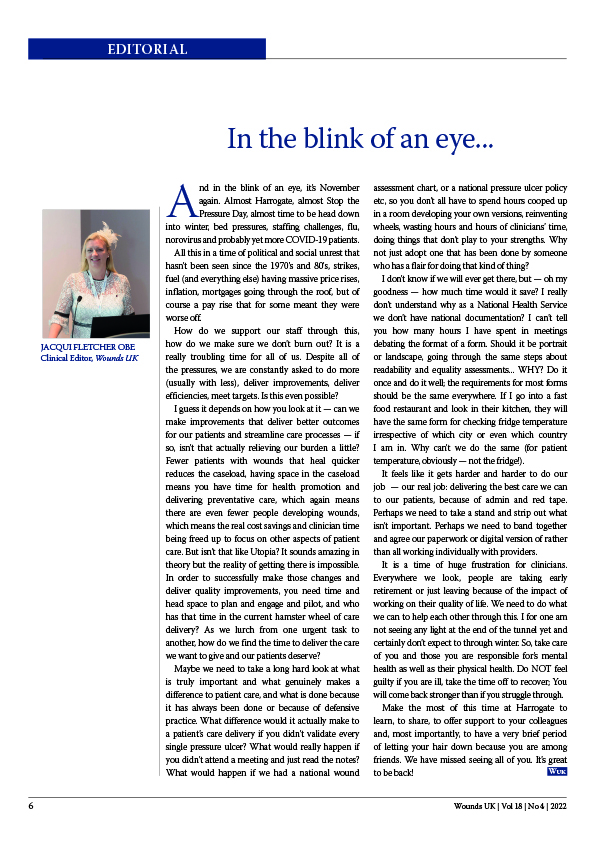It’s that time of year again, so I am are looking forward to our conference in Harrogate. I’m always pleased with the programme but this year we have really got some great sessions, my three favourites are:
- Drugs in wound healing: a practical guide by Annie Price and Amy Ferris
- Blood tests and chronic wounds by Annie Price
- Applied Anatomy which I am delighted to be presenting with the Mr Majumder, his teaching style is fabulous so make sure you come along.
I am also really looking forward to our opening session from Leanne Atkin, who will be setting the tone for the event, getting everyone involved and hopefully helping to raise morale.
We had a huge number of submissions for posters and free papers, the standard was exceptionally high so we have given three hours to free paper presentations, please do go along, many will be first time presenters so remember to be kind and supportive in your questions. We will be awarding the free paper prize just before the dinner on Tuesday, so if you have submitted and been awarded a free paper make sure you come along.
As always there will be a great exhibition, supported by our commercial colleagues and of course the ever fabulous conference dinner — your chance to network and consolidate friendships. The theme this year is festival glamour! Black tie but with glittery face paints, headbands, gold or diamanté tattoos or why not throw in some flowers, feathers or fur!
This year we are using the Whoava app. Using the app you can talk with other delegates, ask questions of speakers, plan the sessions you want to attend, take notes, keep and share photos, among many other things. If you are anxious about taking notes, I have used it previously and post-event received an email with all my notes in, it was amazing. Do download and make the most of it. Furthermore, we are hoping to create a people focused skin tone resource, so if you want to be part of our hall of fame, whatever your skin colour or tone, come along to our selfie booth (Stand 17c) take your picture and submit via Whoava!
What else has happened, well I feel like the world has finally returned to normal, we are all out and about, we survived the strikes (although some are still ongoing) and are all hunkering down ready for the long haul of winter pressure. I think we will see a resurgence of the COVID-19 virus, there is a lot of it about all ready, but hopefully we wont be in the same awful situation we were three and a half years ago.
It seems clinicians are getting busier and busier (no surprise as there are so many vacancies) and that the most fundamental aspects of care like skin checks are being missed. I have written previously about should we be simplifying and standardising elements of clinical practice, but it is becoming imperative to simplify and streamline to ensure that we/our colleagues can focus on getting those important elements of care delivered. Skin assessment and care is the same for all wound types and maybe if we gave that message it would emphasise the importance rather than siloing it into skin care for PU, skin care for prevention of skin tears, skin care as part of leg/foot ulcer care where it suddenly feels like multiple tasks and so may get missed or badly documented.
I think we also need to improve our pain assessment and management. Pain type, intensity and duration is a common section in all wound assessment forms, but how often is it recorded and the only action taken is to apologise to the patient as you do something painful to them? Why are we not working to reduce pain or to reduce the impact of painful stimuli? What can we learn from our paediatric colleagues (great paediatric sessions on the Harrogate programme make sure you see those too!), they spend more time on techniques to minimise pain rather than documenting pain. They use a whole range of distraction techniques from reading, through using digital distraction and supportive others and specifically alternative nerve stimulation with things like ‘buzzy bees’, no I hadn’t heard of them either! Why don’t we do this for adult patients? Actually at what point/age do we stop doing this and decide that someone is ‘big enough’ to just grit their teeth and manage the pain? It’s a challenge, but a challenge that needs addressing, so lets all think about simple things we can do to make our patient’s lives better.
Have a good Harrogate, I am really looking forward to meeting everyone again and for those of you who can’t make it – don’t worry we will be videoing a lot of sessions so you can watch on demand.







